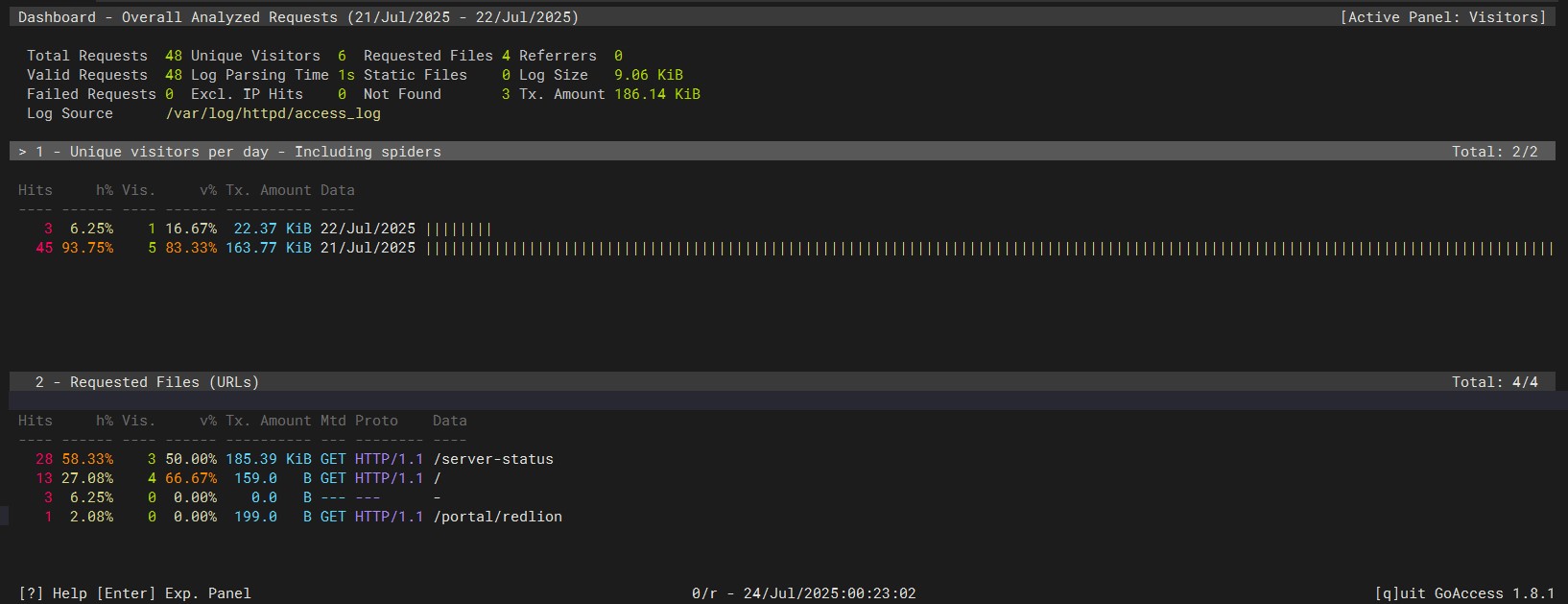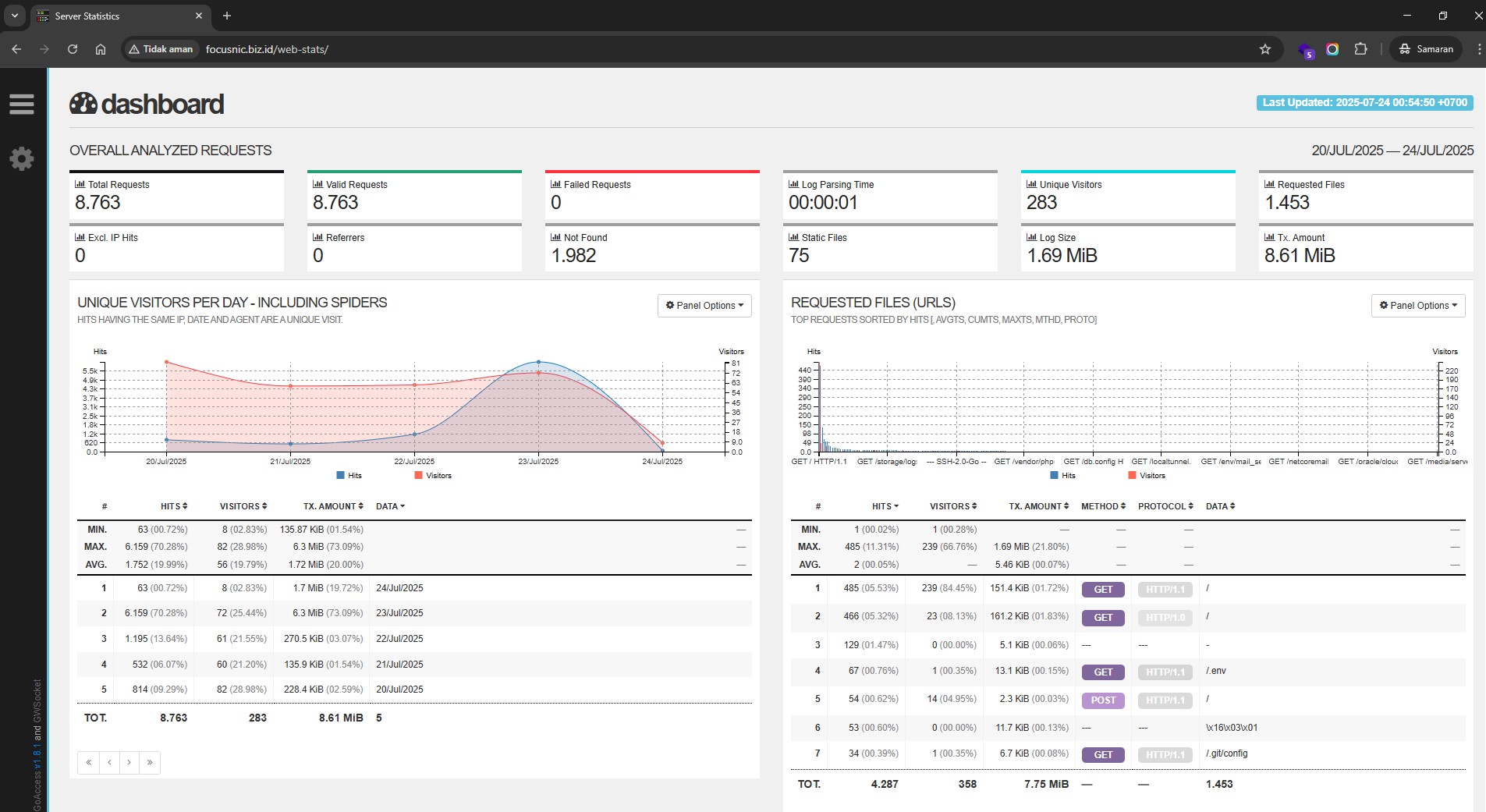GoAccess
Monitoring web server traffic in real-time is a key requirement in managing production systems. To that end, GoAccess offers a lightweight yet highly informative log analysis solution for web servers. In this guide, we will cover in depth, detail, and systematically how to install and configure GoAccess on an AlmaLinux 8-based Apache Web Server, enabling accurate and interactive statistical visualizations in real time.
GoAccess is an open-source, terminal-based application designed to monitor web server logs directly. Its advantages include:
- Interactive terminal-based display.
- Supports real-time HTML output.
- Low resource consumption, ideal for production servers.
- Supports various log formats: Apache, Nginx, AWS CloudFront, and others.
GoAccess is extremely useful for identifying highest traffic, popular URLs, HTTP statuses, user agents, and even visitor countries, making it an essential tool for sys admins and devops
Prerequisite
- Full
rootaccess - Basic Linux Command Line
- Security
- Apache/HTTPD installed
- Domain (optional)
- Timezone configured
Install GoAccess
Before installing, it is recommended to update the server and also add the EPEL repository, because GoAccess is not available in the default AlmaLinux repositories:
dnf update -y
dnf install epel-release -y
Then run the following command to install GoAccess:
dnf install goaccess -y
Verify GoAccess installation:
goaccess --version
Output example:
GoAccess - 1.8.1.
For more details visit: https://goaccess.io/
Copyright (C) 2009-2023 by Gerardo Orellana
Virtualhost for GoAccess
It is assumed that the GoAccess installation will be applied to each domain or virtualhost.
Make sure Apache is installed, if it is not installed, please run the following command:
dnf install httpd -y
systemctl enable --now httpd
Make sure port 80/443 is allowed when using firewalld, run the following command:
firewall-cmd --permanent --add-service={http,https}
firewall-cmd --reload
Then create the following virtualhost or adjust the configuration:
nano /etc/httpd/conf.d/focusnic.biz.id.conf
Fill in the following parameters:
<VirtualHost *:80>
ServerAdmin webmaster@focusnic.biz.id
ServerName focusnic.biz.id
ServerAlias www.focusnic.biz.id
DocumentRoot /var/www/focusnic.biz.id/public_html
Alias /web-stats "/var/www/focusnic.biz.id/goaccess"
<Directory "/var/www/focusnic.biz.id/goaccess">
AuthType Basic
AuthName "GoAccess Protected"
AuthUserFile "/etc/httpd/.htpasswd-focusnic"
Require valid-user
AllowOverride None
DirectoryIndex index.html
</Directory>
ErrorLog /var/log/httpd/focusnic.biz.id-error.log
CustomLog /var/log/httpd/focusnic.biz.id-access.log combined
</VirtualHost>
Create a user and password admin to access the GoAccess page:
htpasswd -c /etc/httpd/.htpasswd admin
Then create a directory for the virtualhost above:
mkdir -p /var/www/focusnic.biz.id/public_html
Then restart Apache after making the changes:
apachectl configtest
systemctl restart httpd
GoAccess Configuration
By default, Apache uses the Combined log format, which looks like this:
Make sure your logs are located in /var/log/httpd/access_log. If using a VirtualHost, the location may vary.
LogFormat "%h %l %u %t \"%r\" %>s %b \"%{Referer}i\" \"%{User-Agent}i\"" combined
Then run GoAccess in terminal mode with the following command:
goaccess /var/log/httpd/access_log --log-format=COMBINED --real-time-html
Here is an example of what it looks like

Generate Static GoAccess
Make sure you have created a virtual host and user authentication according to the guide above.
Run the following command to create a static GoAccess report and its directory:
mkdir /var/www/focusnic.biz.id/goaccess
goaccess /var/log/httpd/focusnic.biz.id-access.log --log-format=COMBINED -o /var/www/focusnic.biz.id/goaccess/index.html
Here is an example of the output:
[PARSING /var/log/httpd/focusnic.biz.id-access.log] {7,280} @ {0/s}@ {0/s}
Cleaning up resources...
Then access via browser by typing http://focusnic.biz.id/web-stats make sure the user and password have been configured.

Alternatively, you can download the file located at /var/www/focusnic.biz.id/goaccess/index.html and run it directly on your computer.
GoAccess Report Automation
Assume the storage and log layout is as follows:
/var/log/httpd/$DOMAIN-access.log= access log for domain/var/www/$DOMAIN/goaccess= directory to save GoAccess generated results
Create the following script:
nano /root/goaccess-daily-report.sh
Fill in the following script:
#!/bin/bash
# Directory source logs and destination of result GoAccess
LOG_DIR="/var/log/httpd"
WEB_DIR="/var/www"
# Find all logs ending -access.log
for logfile in "$LOG_DIR"/*-access.log; do
# Get domain name file log
filename=$(basename "$logfile")
domain="${filename%-access.log}"
# /goaccess is target stored logs GoAccess
output_dir="$WEB_DIR/$domain/goaccess"
output_file="$output_dir/index.html"
# Create /goaccess if it's not presented
mkdir -p "$output_dir"
# Run GoAccess
echo "Processing $domain ..."
goaccess "$logfile" \
--log-format=COMBINED \
--output="$output_file"
done
Then adjust permissions and run the script:
chmod +x /root/goaccess-daily-report.sh
./goaccess-daily-report.sh
Output example:
Processing focusnic.biz.id ...
[PARSING /var/log/httpd/focusnic.biz.id-access.log] {7,266} @ {0/s}@ {0/s}
Cleaning up resources...
Add to Cron to run daily at 00:00
crontab -e
Fill in the following parameters
0 0 * * * /root/goaccess-daily-report.sh
Real-time GoAccess
Make sure you have created a virtual host and user authentication according to the guide above.
Run the following command to create a GoAccess real-time report:
mkdir /var/www/focusnic.biz.id/goaccess
goaccess /var/log/httpd/focusnic.biz.id-access.log --log-format=COMBINED -o /var/www/focusnic.biz.id/goaccess/index.html --real-time-html --daemonize --port=7890 --ws-url=focusnic.biz.id
Open port 7890 for websocket:
firewall-cmd --permanent --add-port=7890/tcp
firewall-cmd --reload
Then access via browser by typing http://focusnic.biz.id/web-stats make sure the user and password have been configured.
Because GoAccess WebSockets are unprotected by default, meaning they don't require authentication, we recommend using static reports for greater security. If the websocket port 7890 is publicly accessible:
- Anyone can open a connection to
ws://your-ip:7890from a browser or tool likewscatand receive your log data. - Sensitive information such as:
- Visitor IP,
- Accessed URL,
- HTTP Status,
- Referrer,
- User-Agent
Troubleshooting
- GoAccess Statistics Report Doesn't Appear in Browser
Possible Causes:
- The
/var/www/<domain>/goaccess/folder hasn't been created. - The
index.htmlfile hasn't been generated (check cron/script syntax). - Insufficient permissions (
chmod,chown).
Solution:
- Run the script manually for testing:
bash /root/goaccess-daily-report.sh
- Make sure Apache can read the folder:
chmod -R 755 /var/www/<domain>/goaccess
chown -R apache:apache /var/www/<domain>/goaccess
- Log is too large, GoAccess is slow or fails
Possible causes:
- The log file is very large (several hundred MB or more).
- Insufficient server resources (RAM, CPU).
Solution:
- Use
logrotateto make the log daily and lighter.
- Cron
goaccess-daily-report.shis not running
Possible causes:
- Cron is not enabled or does not have executable permissions.
- The script is not configured with
chmod +x.
- The script doesn't find a new log file after adding a domain
The log file format doesn't match the *-access.log pattern. Make sure the log file name matches /var/log/httpd/<domain>-access.log.
- Log Format Error
If GoAccess displays a format error, make sure you're using --log-format=COMBINED and that your Apache log format is combined. Check /etc/httpd/conf/httpd.conf.
Conclusion
By using GoAccess on Apache Web Server on AlmaLinux 8, we can present visitor statistics in real-time, efficiently, and visually appealing. Easy integration with Apache makes it an ideal choice for administrators who need lightweight yet powerful log monitoring. Whether on a small or large scale, GoAccess can help us analyze traffic patterns, detect anomalies, and develop better web server optimization strategies.
Q: Does GoAccess support logging systems other than Apache?
A: Yes, GoAccess also supports Nginx, Amazon S3, AWS CloudFront, and custom log formats.
Q: Can GoAccess be used without HTML output?
A: Yes. GoAccess can be run purely in terminal mode for internal auditing or quick debugging.
Q: Can GoAccess run on a VPS with limited resources?
A: Absolutely. GoAccess is lightweight and doesn't consume much memory or CPU, making it perfect for small servers.
Q: Does GoAccess store statistics?
A: Not by default. If you want to store historical data, you can use the --persist option or integrate with an external database.
Q: Can you use SSL on GoAccess?
A: Yes, you can simply make /var/www/<domain>/goaccess part of your HTTPS VirtualHost (:443), and make sure the SSL certificate is installed.